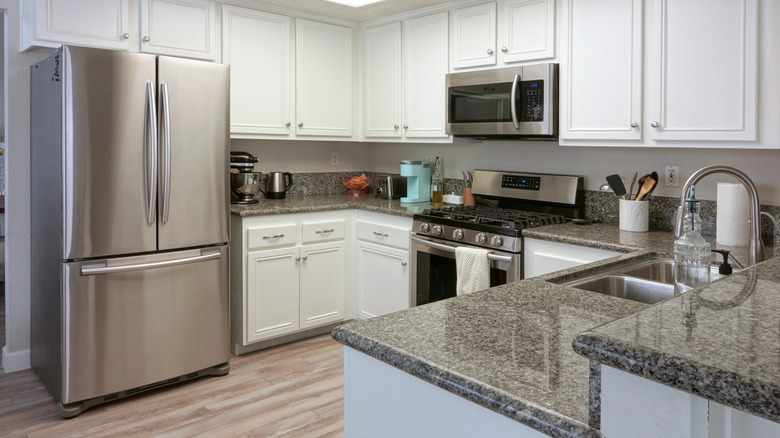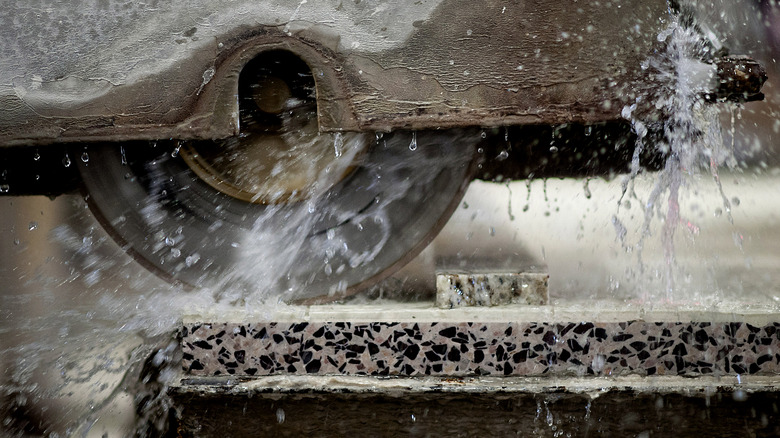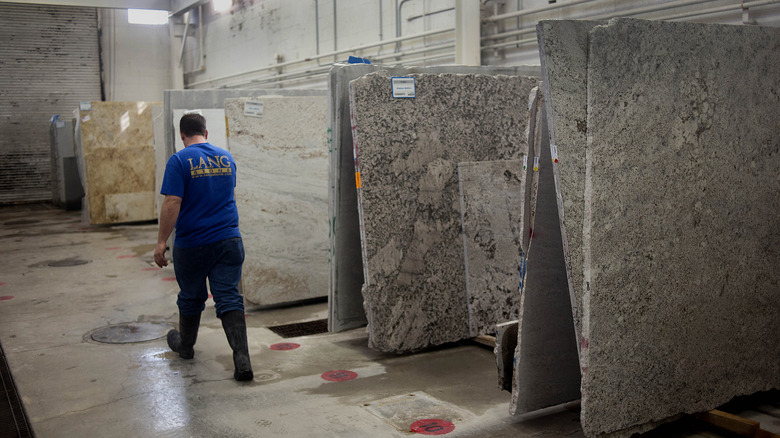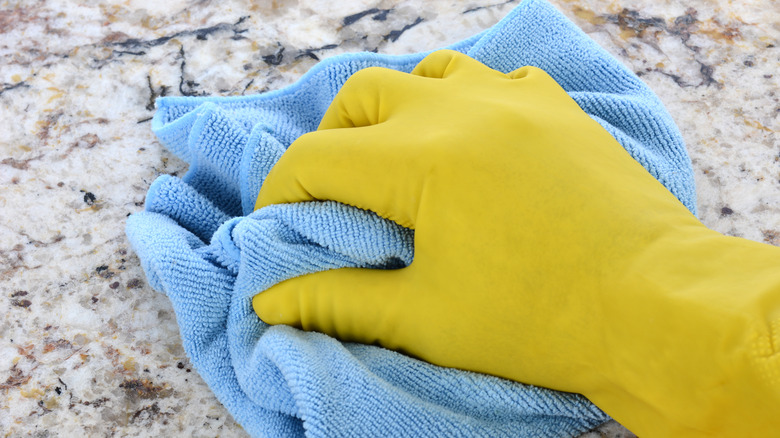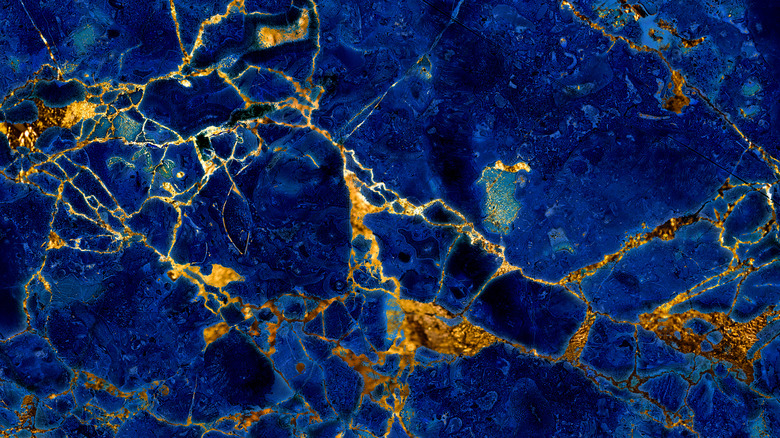Mistakes Everyone Makes When Buying Granite Countertops
Granite countertops are one of the most sought-after elements of a new kitchen. Remodeling gives homeowners the ability to reimagine the space of the kitchen in any way that suits their particular needs, and for many, this means adding granite is a must. Vox reports that granite counters have exploded in popularity since the turn of the century as a result of changing design trends and an increase in the availability of granite since the late 90s.
This availability along with a reduction in cost preempted an amazing uptick in the use of granite in American kitchens. But granite isn't just a countertop of convenience. The stone is also incredibly durable and resists chipping and breakages. It can also withstand the direct application of heat from a pan just coming off the stove, and it's remarkably easy to clean, explains Granite Selection. However, the installation of a new granite countertop comes with several challenges, and without careful planning, homeowners can easily make mistakes that prove costly to repair.
Plan and measure first
Planning is a key component in the successful installation of a new granite countertop. Granite slabs are thick and heavy, and as such, require special machinery to cut them to size. This means that you need to carefully measure every aspect of the planned countertop multiple times, otherwise, the finished product may not accurately match the underlying cabinet construction, notes Tops Kitchen Cabinet. Once you've placed an order for a granite countertop, there's no going back. The supplier will cut the stone to your exacting measurements and deliver the product for installation.
When working on any major home improvement project, it's important to choose a contractor that's professional and knowledgeable. This is true for granite installation as well, since your contractor can assist with the measurement and planning phase, and then order the correct sized granite for your space. Your contractor can also help you select a finish that complements the kitchen design. One of the key decisions when selecting granite is whether to use a honed or a polished slab, warns Granite Selection. This is crucial to the outcome of the project, as a honed granite top has a non-reflective satin finish, whereas polished granite has a glossy shine that makes darker tones stand out. As Granite Selection explains, honed granite offers a softer, natural look, while polished granite adds a modern design element that's luscious and vibrant.
Don't prize color over quality
Tops Kitchen Cabinet recommends keeping your focus directed on the quality of the stone rather than its specific color. Darker colors often fit better into the overall theme of a modern kitchen, and they are easier to clean because they tend to incorporate a tighter rock grain than lighter color options. In addition, the gradient of color found in most granite slabs runs across multiple shades, which means that you'll likely have a broad selection when it comes to picking out a granite slab that suits your expectations.
The most important feature, however, is the quality of the stone. Everything from rock grain to polishing and finishing will play a role in the longevity, smoothness, and overall beauty of the granite countertop. A high-quality granite slab is one that has been prepared with great care to reduce the porosity, therefore, seeking out a stone that shows little signs of pitting or cracking is a must, explains Granite Selection. Additionally, the origin of the granite is a key factor. Lower-grade stone is often sourced from China, whereas high-quality granite comes mainly from India and Brazil. Meticulously considering the source of the stone and its overall quality is an essential step if you want the countertop to remain a centerpiece in your home for the years to come.
Don't forget to keep granite countertops shining brilliantly
Granite countertops arrive with a natural shine to them. This is because a granite slab is painstakingly polished before it leaves a showroom or factory to be installed in your kitchen. Polishing the granite with a shine finish rather than a matte look will ensure that the countertop glows for a long time to come. Yet, over time, granite countertops can dull as life takes its toll on the object. Keeping your counters shining is a matter of simple care routines.
Marble.com reports that the best way to extend the length of a granite countertop's shine is to clean the surface regularly. In kitchens, this is a routine task, but taking the extra step to ensure that the counter is dried as well will keep the sparkle alive for a very long time. Wiping down the surface to remove food debris or other elements that should be cleared away will give you a smooth surface to work with. Adding a mild dish soap and warm water lifts off any dirt or dried liquids that may be present on the granite surface.
Then simply drying the countertop with a paper towel will bring out the natural shine that you know and love.
Enhancing the polish
Another approach used when typical cleaning no longer cuts it is to apply baking soda slurries or even cooking oil to the surface to reanimate the shine. Pro Housekeepers notes that either of these products can be used to bring natural luster back to the granite surface. A mixture of one part warm water and three parts baking soda provides a great natural polishing agent for granite counters. Applying the paste to the surface and working it around in small circles gives you a shiny resurrection that is a welcome change for a kitchen that's lost a bit of its newness. Buffing out the mixture with a clean cloth like you might finish off a car polishing job, then wiping the surface with a damp cloth to complete the job will leave the granite shimmering.
Alternatively, you might consider applying a very fine film of neutral cooking oil to the countertop to give it a natural protection against moisture and bring out the shine. Vegetable oil, sunflower oil, and other neutral oils are the ideal selection for seasoning cast iron and carbon steel pans (via Southern Living). The same principle applies to buffing up the countertop. Using too much oil can stain your counter, altering its aesthetic, but when used sparingly it will buff up the counter with ease.
With either method, Pro Housekeepers notes that you shouldn't forget about the edges for a cohesive and smooth finish that's sure to turn heads.
